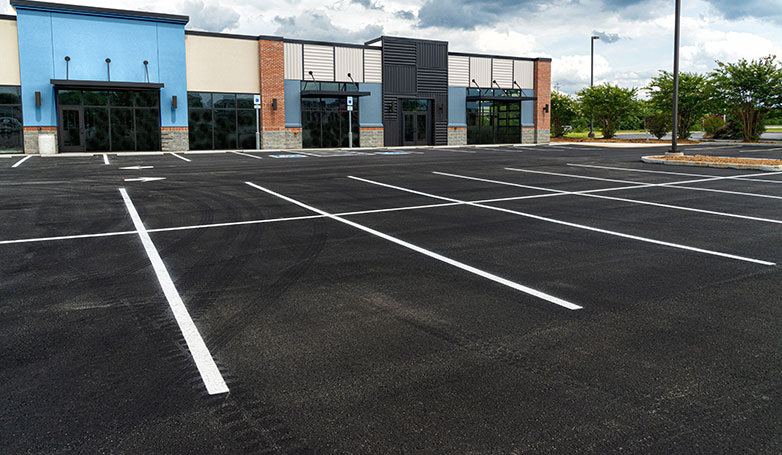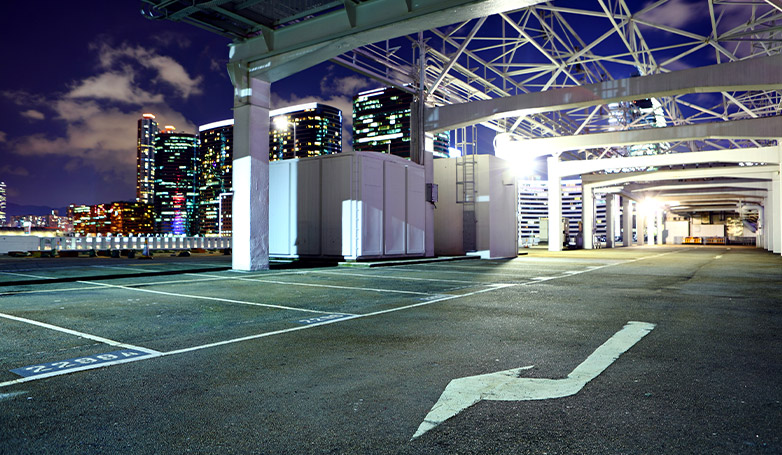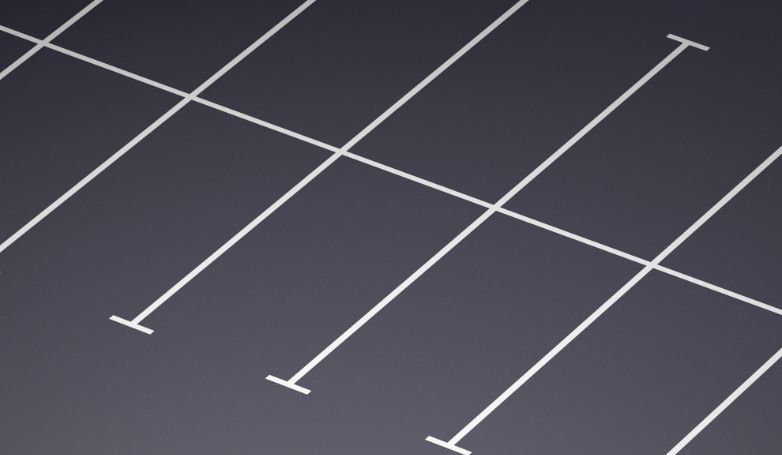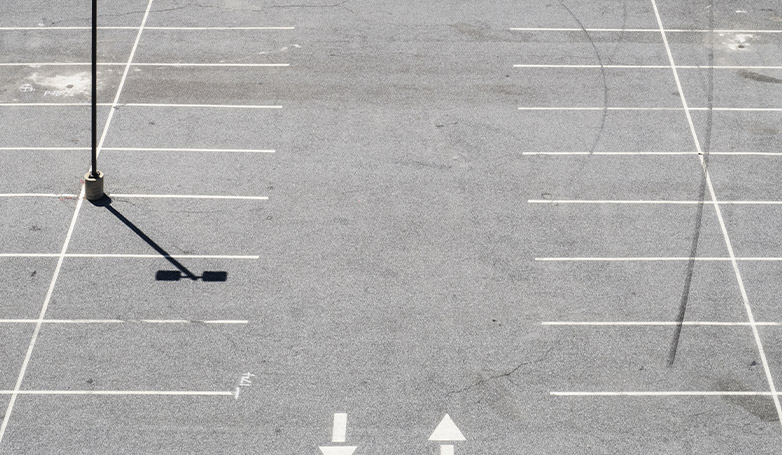Parking Lot Striping Cost – Comprehensive Budgeting Guide
A well-striped parking lot is crucial for safety and aesthetics in commercial or public spaces. Knowing the costs for striping or restriping is essential for your project’s budgeting and planning.
Parking lot striping cost varies based on several factors, including the size of the lot, the type of paint used, the complexity of the layout, and geographic location. On average, you might expect to spend anywhere from $400 to $700 for a standard parking lot with 30-50 spaces. However, this figure is a starting point, and prices can fluctuate depending on your specific needs and the unique characteristics of your parking area.
Next, we’ll delve into the factors influencing parking lot striping costs, encompassing material types, labor, special markings, and maintenance. Our guide is designed to assist you in managing parking lot striping costs effectively, whether for a small business lot or a larger facility. Continue reading for a deeper understanding and valuable tips for a smart investment.
Parking Lot Striping Costs
After completing the paving of your parking lot, the next vital step is striping, crucial for ensuring safe and organized vehicle movement. The pricing for parking lot striping generally falls into two categories: per linear foot and per individual parking stall line
Cost Per Linear Foot
| Cost Type | Price Range | Factors Influencing Cost |
|---|---|---|
| Cost Per Linear Foot | $.20 to $1.00 per linear foot | Paint Quality, Line Thickness, Geographic Location |
This widely-used calculation method ranges from $.20 to $1.00 per linear foot, with the price variation dependent on several factors. The quality of the paint plays a significant role in determining the cost. Opting for higher quality, long-lasting paint results in a higher price. The thickness of the lines also influences the cost. Standard line thickness is about four inches, but requiring thicker lines for enhanced visibility can push the price up. Another contributing factor is the geographic location, as labor and material costs vary regionally.
Cost Per Parking Stall Line
| Cost Type | Price Range | Factors Influencing Cost |
|---|---|---|
| Cost Per Parking Stall Line | $4 to $5 per stall | Special Markings, Number of Stalls |
Alternatively, striping a single parking stall typically costs between $4 to $5. This price can increase based on specific requirements. Special markings, such as handicap spaces, no-parking zones, and directional arrows, involve additional costs due to their complexity and the need for specific types of paint. The total number of stalls also impacts the overall cost. Striping a larger number of stalls might offer some discounts for bulk work, but in general, more stalls equate to a higher total cost.
Factors Influencing Parking Lot Striping Costs
| Factor | Impact on Cost |
|---|---|
| Specialized Markings (Logos, Arrows, Zones) | Increases due to complexity and materials |
| Curb Marking | Around $1 per linear foot |
| Use of Color in Markings | Higher due to special paint |
| Scale of the Parking Lot | Larger lots incur higher costs |
When determining the cost for parking lot striping, several additional factors come into play that can influence the final price. Understanding these elements is crucial for a more accurate budget estimation.
Specialized Markings and Additions
One of the primary factors that can increase costs is the need for specialized markings. If your parking lot requires custom elements such as company logos, directional arrows, loading zones, or designated fire lanes, these additions will elevate the overall cost. These specialized markings often require extra time, precision, and sometimes different types of paint or materials, which can be more expensive.
Curb Marking Costs

Another aspect to consider is curb marking. If your project includes marking curbs, this is typically charged at about $1 per linear foot. The cost can vary depending on the complexity of the markings and the type of paint used.
Use of Color in Markings
Incorporating colored paint for certain markings can also impact your budget. Color-specific paint is often required for features like handicapped spaces or specific directional indications. These paints can be more costly than standard white or yellow paints, both in terms of material costs and the additional labor required for application.
Scale of the Parking Lot
The overall size of your parking lot plays a significant role in the cost calculation. Larger parking lots not only require more striping but may also necessitate a greater number of specialized additions such as handicapped spaces or specific visitor parking areas. The larger the area, the more materials and labor hours are needed, leading to higher overall costs.
By considering these factors, you can gain a more detailed understanding of what influences the costs of parking lot striping and how these elements might affect your specific project. This insight is valuable for planning and budgeting effectively for your parking lot maintenance or renovation.
The Cost Of Different Parking Lot Lines
There are different costs for different types of lines that you’ll need to keep in mind. These line markings can vary in price, though are often anywhere from $20 to $30. Here are some of the different lines you might expect to pay for and their average costs:
| Parking Lot Line Type | Cost Range |
|---|---|
| Single Line for Parking Lot Stall | $4 to $5 |
| Stop Line | $20 to $30 |
| Stenciled Parking Space Letters | $2 to $4 per space letter |
| Stenciled Parking Space Numbers | $1.50 to $3.50 per number |
| Handicapped Stalls | $25 to $30 per stall |
| Arrows | $10 to $20 per arrow |
| Pedestrian Crosswalks | $50 to $75 per crosswalk |
Pricing and Recommendations for Painting Angled Stalls
If you decide to paint angled stalls, note that you will likely pay more than you would be painting regular stalls.
Keep in mind that these costs will vary depending on the number of lines that you need in your parking lot, the types of lines that you require, and the amount of paint that you need to use to finish the job.
A professional painting company will often pay anywhere from $80 to $150 for a five-gallon tub of paint. The parking lot striping company will usually provide you with this cost upfront in your initial quote.
We highly recommend using water-based acrylic if you want your parking lot to look its best and last the longest.
Parking Lot Restriping Cost

Parking lot restriping is a crucial maintenance task that not only enhances the appearance of your parking area but also ensures compliance with safety standards. The cost of restriping a parking lot is generally comparable to the initial striping costs. For a standard-sized parking lot with 30 to 50 spaces, the price range typically falls between $300 to $700. However, several factors can influence the final cost, making it essential to consider these variables for a more accurate estimate.
Factors Affecting Striping Costs
- Condition of Existing Lines: If the existing striping is heavily faded or worn, more preparatory work and materials may be needed. This ensures the new paint adheres properly and is visible, potentially increasing costs.
- Changes in Layout or Design: If you plan to alter the layout of the parking lot during restriping, this could involve additional planning and labor, impacting the overall cost. This includes adding or removing spaces, changing the flow of traffic, or modifying space sizes.
- Type of Paint Used: The choice of paint for restriping can significantly affect the price. High-quality, durable paints that last longer and offer better visibility might be more expensive but can be more cost-effective in the long run due to reduced frequency of restriping.
- Regulatory Compliance: Ensuring compliance with local regulations, including the Americans with Disabilities Act (ADA) for handicapped spaces, can influence the cost. This might include adding specific markings or modifying existing ones to meet current standards.
- Additional Markings: Like initial striping, any extra features such as directional arrows, no-parking zones, or custom logos will add to the cost. These require more time and specialized paints.
- Size and Complexity of the Parking Lot: Larger parking lots or those with a more complex design will naturally incur higher restriping costs due to the increased amount of labor and materials needed.
- Geographic Location: Labor and material costs can vary depending on your location, which can influence the overall cost of the restriping project.
Importance of Regular Restriping
Regular restriping is not just about maintaining aesthetics; it’s also about safety and compliance. Clear and visible parking lot lines are essential for the orderly flow of traffic and pedestrian safety. Furthermore, well-maintained parking lots can leave a positive impression on visitors and customers, reflecting the professionalism of your business or facility.
By understanding these factors, you can better budget for your parking lot restriping project and ensure that your parking area remains functional, safe, and visually appealing.
How Much Time Is Needed To Stripe or Restripe a Parking Lot?

The duration required to stripe or restripe a parking lot is influenced by several key factors, each playing a crucial role in the efficiency and effectiveness of the project.
Size and Complexity of the Parking Lot
The overall area and layout of your parking lot significantly impact parking lot striping costs. Larger lots with more spaces or complex designs (like those with numerous directional markings or specialized zones) naturally require more time to complete, affecting the overall parking lot striping cost.
Workforce and Equipment Efficiency
The number of workers assigned to the project and the type of machinery used are significant factors. More workers and advanced striping equipment can expedite the process, whereas fewer workers or basic tools might prolong it. The experience and skill level of the crew also play a part in determining how quickly the job can be done efficiently.
Paint Drying Time
After the paint is applied, drying time is a crucial consideration. On a hot summer day, paint can dry enough for light traffic within an hour. However, to ensure durability and proper curing, a minimum of four hours is often recommended. The type of paint used (water-based vs. solvent-based) also affects drying time, with some formulations drying faster than others.
Weather Conditions
Weather plays a significant role in striping projects. Ideal conditions include a dry, warm day with ample sunlight, which aids in quicker drying and curing of the paint. Conversely, cooler temperatures, high humidity, or lack of sunlight can significantly extend drying times. In colder weather, using solvent-based traffic paint is advisable as it tends to dry faster and more effectively in such conditions.
Pre-Striping Preparation and Post-Striping Care
Prepping the parking lot surface before striping, including cleaning and making necessary repairs, can add to the overall project time. Moreover, consider sealcoating your parking lot before striping. Sealcoating not only protects the asphalt but also provides a smooth, uniform surface that can enhance the adherence and longevity of the striping job.
Each of these factors should be considered when planning a parking lot striping or restriping project. This ensures a smooth process and minimizes downtime for your parking facility. By understanding and managing these elements, you can more accurately predict the timeframe needed to complete the job effectively.
How Much Does It Cost To Remove Parking Lot Striping?

Understanding the cost implications of removing parking lot striping is crucial. This is especially true when planning for repaving, restriping, or redesigning your parking area. While the average cost typically ranges between $200 to $500, several factors can influence the final price. It is essential to consider these aspects for a more precise estimate.
Key Factors Impacting Striping Removal Costs
- Size and Scope of the Project: The larger the area with striping to be removed, the higher the cost. This is due to the increased labor and time required to remove the lines from a larger surface area.
- Type of Striping Material Used: Different striping materials (paint, thermoplastic, tape, etc.) have varying levels of difficulty for removal. Some materials may require more intensive labor or specialized equipment to remove, impacting the overall cost.
- Removal Method Employed: There are several methods for striping removal, including grinding, blasting (with sand or water), and chemical treatments. Each method has different equipment and labor cost implications. For example, grinding might be more time-consuming and labor-intensive compared to blasting methods.
- Condition of the Pavement: The existing condition of the pavement can affect the removal process. Rough or damaged surfaces may complicate the removal. This complication can potentially increase costs. This is due to the need for more careful or repeated processes to avoid further damage to the pavement.
- Disposal of Removed Materials: The cost of properly disposing of the removed striping materials can also factor into the overall cost. Environmental regulations and local disposal fees can vary, impacting the total price.
- Geographic Location: Labor and equipment rental costs can vary significantly based on the location, which can influence the total cost of the striping removal project.
Additional Considerations
- Timing and Accessibility: Projects with tight deadlines or those in areas with limited accessibility might incur higher costs. This is due to the need for expedited work or additional logistics planning.
- Post-Removal Surface Treatment: If the removal process leaves behind any damage or noticeable marks on the pavement, additional surface treatments may be required. This could add to the total expense.
By taking these factors into account, you can gain a more detailed and accurate understanding of what to expect in terms of costs for removing parking lot striping. This enables better budgeting and planning for your project.
Final Thoughts
We hope that you now have a better idea of what you can expect from your parking lot striping cost. Once done, it’s a good idea to restripe your parking lot every 18 to 24 months to keep it looking fresh and new.
Of course, the amount of time you can leave in between restriping depends on whether or not you have high-volume traffic and what kind of climate you live in.
Here at Paving Finder, we’re consistently looking for new ways to help people find the best paving services for their needs. We highly recommend joining our pro network if you want to get in touch with top-rated paving professionals in your area.


